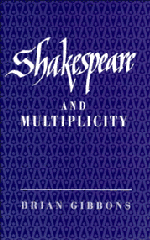Book contents
- Frontmatter
- Contents
- Acknowledgements
- 1 Introduction
- 2 Fabled Cymbeline
- 3 A speechless dialect: interpreting the human body in Shakespeare's plays
- 4 Shakespeare's ‘road of excess’: Titus Andronicus, The Taming of the Shrew, King Lear
- 5 Always topical: Measure for Measure
- 6 Amorous fictions in As You Like It
- 7 Unstable Proteus: Marlowe and Antony and Cleopatra
- 8 Multiplicity
- Notes
- Bibliography
- Index
5 - Always topical: Measure for Measure
Published online by Cambridge University Press: 30 September 2009
- Frontmatter
- Contents
- Acknowledgements
- 1 Introduction
- 2 Fabled Cymbeline
- 3 A speechless dialect: interpreting the human body in Shakespeare's plays
- 4 Shakespeare's ‘road of excess’: Titus Andronicus, The Taming of the Shrew, King Lear
- 5 Always topical: Measure for Measure
- 6 Amorous fictions in As You Like It
- 7 Unstable Proteus: Marlowe and Antony and Cleopatra
- 8 Multiplicity
- Notes
- Bibliography
- Index
Summary
Measure for Measure (1604) stages, clearly, certain contentious issues which the interval between Queen Elizabeth I's death and the arrival of the new King James must have brought to mind. In this play the Duke in a sense abdicates, so that both he and his subjects have a chance to experience society without a sovereign. They are involved in witnessing majesty, defamiliarised, precariously as much as sensationally achieving restoration. Measure for Measure's readiness to imagine a form of abdication, and in terms more down to earth than the sublime and apocalyptic, has provoked surprising reactions in recent generations of British directors. Thus however much energy Peter Brook may have found in the play's ‘rough’ element, in his admirable and influential production in 1950 he endowed his Duke with great ‘holiness’ (these terms are from his book The Empty Space, Harmondsworth, 1972). Furthermore, Brook made substantial cuts to protect the Duke from his author's irreverence. Brook presumably did so as part of his scheme to stress the play's contrasts of ‘rough’ and ‘holy’, although stage productions generally in the 1940s and 1950s protected the Duke. The national trauma of Edward VIII's 1936 abdication, followed by George VI's admired performance during the 1939–45 Second World War, which re-established the monarchy's prestige, was no doubt an influence (whether unconscious or conscious) in presenting the Duke: thus Anthony Quayle, in 1956, gave his Duke a large crucifix to carry about, to make him above criticism. Early in Measure for Measure's stage history, in the Restoration theatre, began the radical adaptation (and massive cutting of its low-life) in order to suppress its provocativeness.
- Type
- Chapter
- Information
- Shakespeare and Multiplicity , pp. 117 - 152Publisher: Cambridge University PressPrint publication year: 1993



